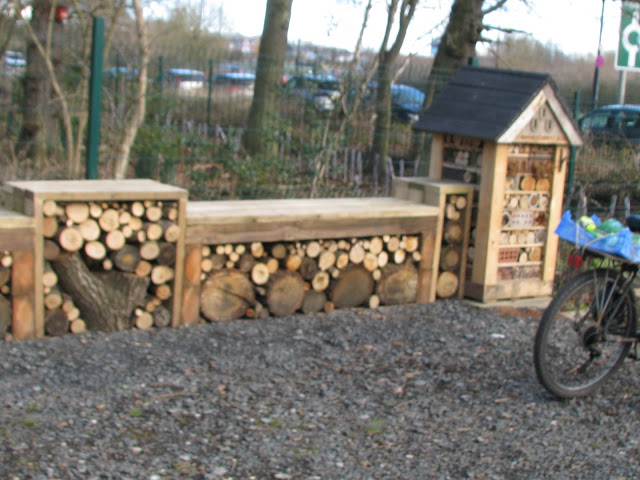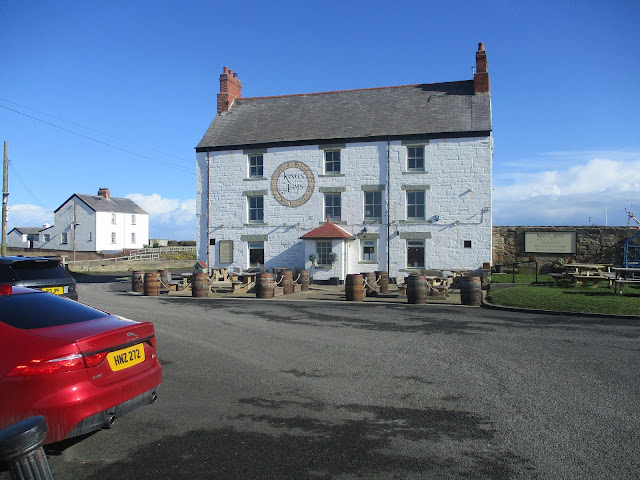Birds, Big Waters, Boots and Blyth.
Wednesday March 8
In order to aid the post operation recovery of one of the team two of us are out for a day's bird watching.
First stop Gosforth Nature Reserve, run by the Natural History Society of Northumbria. And well run too, great improvements since I first visited about 30 years ago. There are four hides, several observation platforms an earth toilet and a classroom near the entrance. The reserve is open to members of the society, non members are asked to pay £5, returnable on joining.
Three of the hides are kept unlocked but one requires a key, available on joining.
The first hide is near the entrance and looks out onto a collection of bird feeders suspended from trees and several tree stumps also provided with feedstuff.
Bug hotel and bench for human diners near the entrance
Bird and bat boxes
Birds and beast at first hide.
Moving on in a clockwise direction round the reserve we came to the second hide which is approached along a well made board walk through the reed beds.
All quiet on the Gosforth lake. Parts were frozen and there was a corpse of a greylag goose on the ice. The warden thought a number of birds had died from Avian Flu which is certainly around.
The third hide, which currently has a new boardwalk entrance under construction, also looks over the lake and was equally quiet. A coot or two and a distant view of a heron.
We walked round the lake to the north side and found the next hide, a new one and the only one which is kept locked, requiring a member's key. It is close to the race course. (near 48 on the map)
Quiet like the others.
Fourth hide view.
Bird watching over we continued on the perimeter path, close to the straight on the race course. Finding a tree that had been felled by storm Arwen we decided to lunch. At this point I realised that somewhere along the way I had lost a glove so we retraced steps and found it.
After a chat with the warden we left the reserve and drove to Big Waters reserve near Brunswick. It is possible to walk there by cheekily crossing the race course, walk through the park area to the old A1, turn right and walk to the Travellers Rest. Turn left and go along the road to the very last house and make your way down the rough track to the lake.
Big Waters is not a natural lake but is a result of mining subsidence. There is a footpath going around the south side but it leads to a forbidden area which has been left to go wild.
Big waters and some inhabitants.
There is a hide accessible from the car park and along a track that appears to be leaving the lake. The hide is run by the Wildlife Trust and needs a members key to get in.
There's an excellent feeding station at Big waters. The squirrel got in.
Contains OS data, copyright. Crown copyright and database right 2023.
Friday March 10th.
The weather forecast promised a day of heavy snow and ice. being sensible septuagarians we considered a gadgie walk was probably not the best of ideas so the proposed expedition was postponed.
I was disappointed because I had bough a new pair of boots a month ago and, having obeyed instructions to wear them round the house for 28 days before accepting them I wanted to give them a try. (Didn't wear them all the time of course, the SWMBO would not have permitted!)
I drove down to South Beach in Blyth, donned the boots and headed along the Eva Black Causeway walk to give them a whirl. I followed the walkers/cyclists path to Seaton Sluice, had a look round and returned.
Car park in Seaton Sluice added by request. It's a free one too.
The Blyth Battery dates back to World War One when Blyth was a submarine base, as it was in WW2 also.
The Kings Arms at Seaton Sluice. Built in 1764, keeps some excellent beer too.
The Lookout House. Now a museum that opens on a Sunday
The cut at Seaton Sluice. Excavated to make access to the harbour easier
The harbour at Seaton Sluice, once exported coal, glass and salt. Quiet now.
And the boots were fine.
























Surprised you didn't see any bambis at the park, the racecourse is home to loads of them.
ReplyDeleteForgot to mention the bambis. Saw at lest two.
ReplyDelete